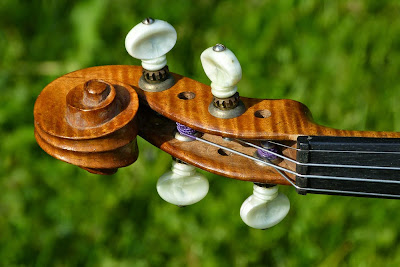1941 T. E. Daniels 4/4 Violin
This very interesting fiddle came my way in a local walk-in. It's labeled (in a position I can't photograph) "T. E. Daniels, Jan 1941" on the inside. It's obviously a home-brew affair and more than likely American-made. I didn't do the instrument justice in the soundclip but it does give an idea of the pure, clean, forward (and loud) tone the instrument has. It's a great voice for use as a fiddle.
Work on this included regluing most of the back seams, a portion of the fingerboard, cutting a new soundpost and fitting a new (old stock) bridge, cleaning, and full setup for fiddle-style action. I also added some uke-style friction pegs to replace missing wood pegs. They're easier to use day-to-day and suit the oddball character. The instrument is crack-free, has nice-quality materials, and is so quirky and odd (in home-made stylings) that it begs a corner in your heart.
The materials are typical: solid spruce (decently tight-grained) on the top and solid maple (flamed) back, sides, and neck. The tailpiece is period (it has real tailgut) but molded and the fingerboard and nut are ebony. The top is nicely carved but has curious shaping at the waist that I'll get to later.
The neck is gorgeous flamed maple. These tuners are uke-style pegs which I've re-used and added funny old brass gears to as "spacers." They don't do anything but look funky (a plus). I've modded a bunch of fiddles this way (from parts-bin tuners) for locals who want something a little easier to take care of for tuning stability. Slipping pegs? Just tighten the set-screw.
I fit this nice-quality old Aubert bridge to the instrument -- as well as a new soundpost.
The "real gut" tailgut on this old molded tailpiece is holding up just fine. The strings on this are something like Dominants with a nylon/perlon core. I don't know the brand but they sound great and suit the instrument.
Nice flame on the back!
Just like the front, this has no purfling at the edges.
The whole thing is carved quite nicely (hence the good tone), but oddly. The back has a gentle "dip" in the middle as it reaches the endblock (though it's swelled as usual in the middle-middle) while the top is carved with a fairly steep arch and tight waist.
The maple is gorgeous, though, no? This has a pretty normal "varnish" finish for the time. It's not fancy but does give a decent glow to the figure in the wood.
Sometime in the past the neck's angle was adjusted back, presumably to get a taller bridge on it. This included a wedge-shaped shim at the heel and (probably) a new fingerboard.
The endpin is interesting, too.
Note that the seams are pretty close to the border of the back here at the endblock.
I'm trying to capture the interesting cut at the waist -- it's a very distinct "ridge" in a half-moon shape on either side.
There, that shows it a bit better.
Whoever T. E. Daniels was -- he/she made a fine-sounding instrument that (now) plays nicely, too.




















Comments